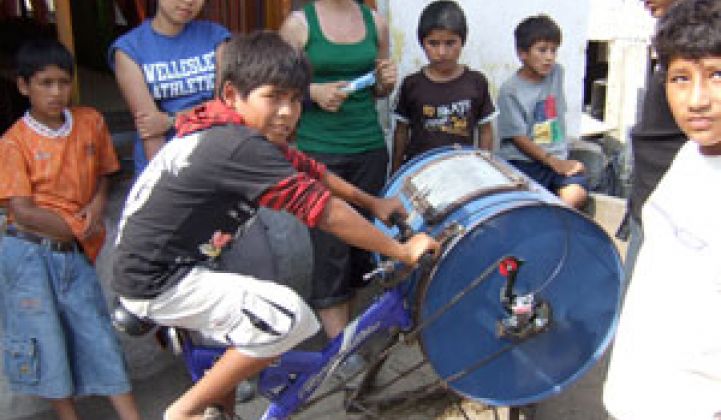What can you make with an oil drum, plastic sheets and an old bike?
A washing machine, of course. At least, that's what some clever researchers at MIT have engineered to create a more environmentally friendly way to do laundry in developing countries.
The idea is to find ways to minimize the need to wash clothes by hand in lakes or rivers. In many poor regions of the world, electricity is a scarce and unreliable commodity, so devising a human-powered washing machine makes better sense.
So how do you make a human-powered washing machine?
The main ingredient is a regular oil drum. First, you take the oil drum and cut it into sections, and then you weld these sections into a smaller barrel that can hold a regular load of clothes. Once that's done, you fashion an inner drum that can be rotated during the washing and spin cycles. Plastic turns out to be a good choice for the inner drum because it doesn't rust. Choosing the kind of plastic that is tough and flexible enough can be tricky. The flexibility would make the parts easy to transport; the toughness would enable the inner drum to withstand the jostling of metal buttons.
To power the machine, the MIT students and staff connected one end of the drum's shaft to a bicycle frame. The bike's chain and some other gear held the bike and the drum together.
"It uses a standard mountain bike gear range," said Gwyndaf Jones, an MIT instructor who worked on the project, in a statement. "The highest gear is for the spin cycle, and the lowest gear is the wash cycle."
Jones took along some students to Peru a month ago to try out their design. They built one at an orphanage with 670 children in a slum called Ventanilla, located just outside of Lima. The MIT folks brought the plastic panels with them from the United States but found other parts locally.
The researchers called their machine bicilavadora, which combines the Spanish words for bicycle and washing machine.
The one they built in Ventanilla worked, but not perfectly. There was some water leakage around the barrel's edge. The bearings for the shaft proved too stiff. The MIT students plan to fix the problems and do more field trials. It took them nearly four years to get to this point.
The cost of building the washing machine will vary depending on where it's being done, of course. The idea is to make it simple enough for locals to build their own. Radu Raduta, an MIT graduate student who designed the inner drum, estimated that the whole set up could cost $165, including labor cost. The inner drum was the most difficult part to build, so the MIT team brought those plastic panels with them to Peru. Raduta said it would cost $50 to make and ship the plastic parts from the United States to other parts of the world.
MIT researchers are very fond of finding novel ways to make use of bicycles. Some of them have converted an exercise bike to charge batteries for powering laptop computers. Other inventive college students have carried out similar projects.
A nonprofit called Inveneo in San Francisco has developed a whole bike- and solar-powered IP telephone and computer system, complete with WiFi, for the developing world.



